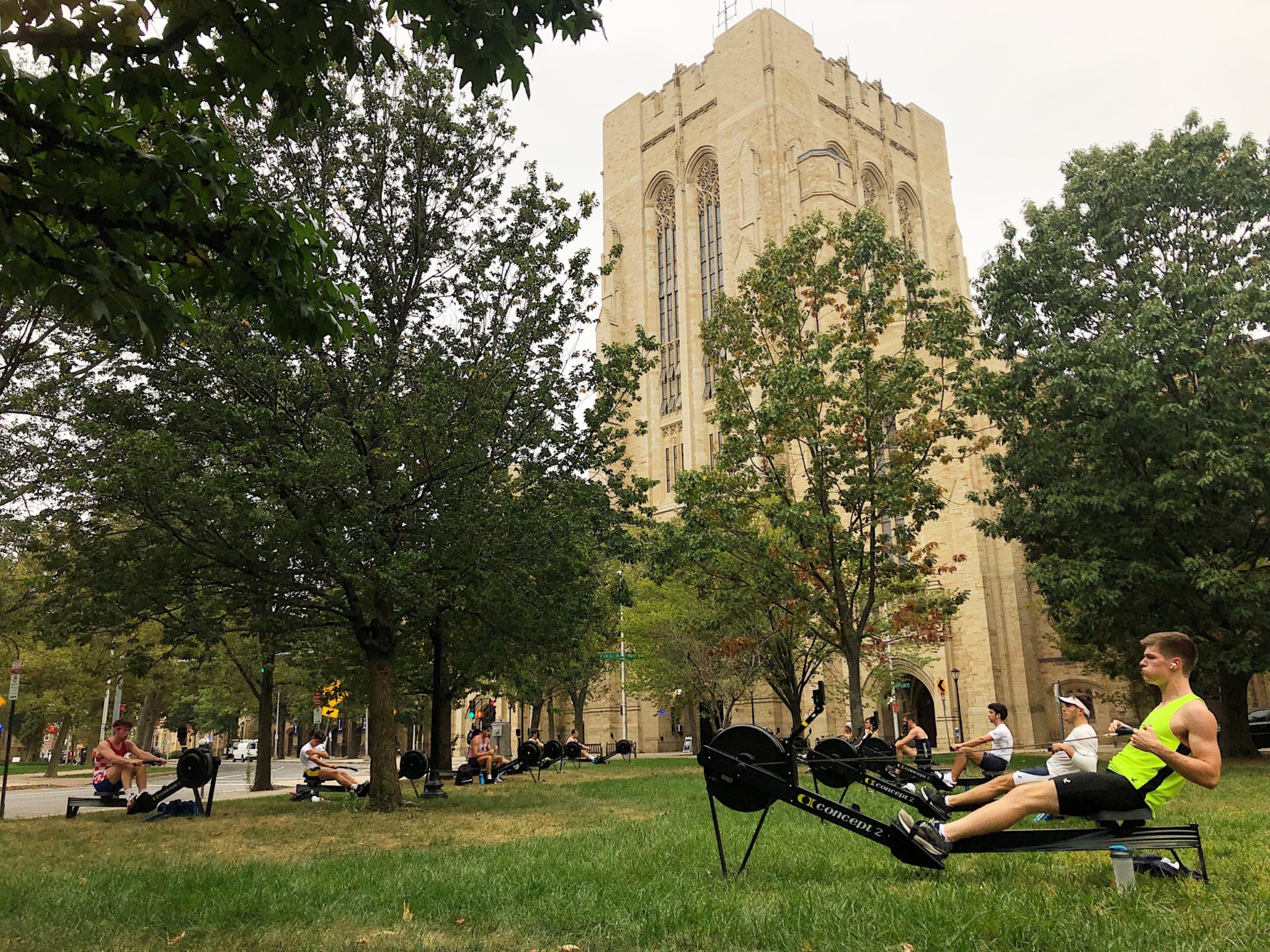CREW: Moving ergs outside, Yale rowers take Phase I in stride
As varsity athletic teams resume practices socially-distanced and masked, the coaches and rowers on Yale’s three crew teams have come up with an innovative way to condition together, moving their ergometers to the Payne Whitney Gymnasium grass.

Amelia Lower
No one passing by Payne Whitney Gymnasium on Saturday morning could miss the sea of socially-distanced ergometers — “ergs” — and sounds of heavy breathing from the Yale lightweight men’s crew team.
The rowers’ exhilarating energy could be felt all the way from Broadway, causing pedestrians to curiously observe the unfamiliar scene.
Beginning early last week, the women’s, heavyweight men’s and lightweight men’s crew teams have assumed a new form of practice outside of Payne Whitney, using their ergs to condition during Phase I of Yale’s three-phase plan for resuming varsity training amid the COVID-19 pandemic. The Yale crew teams are certainly taking advantage of each and every hour they have, holding practices outside six times a week at a distance of 12 feet apart.
“Right now, all we are focused on is doing a great job in Phase I,” said Andrew Card, the head coach of the lightweight men’s team. “We are taking it day by day and one week at a time.”
Each team has a designated time to attend practice each day, and every rower brings their own ergometer out from their team’s rowing tank in the basement to the front or the back of Payne Whitney Gymnasium. Athletes then return to clean each erg after practice. Although each rower is distanced on the lawn, according to Card, “the team dynamic is awesome, and right now, the focus on today is more motivating.”

Similar to the men’s lightweight experience, women’s crew has been enjoying their practices outside together, which has allowed for them to not only train but grow as a cohesive unit.
“I will say our first week was very successful,” said women’s crew head coach Will Porter, who starts his 22nd year at Yale this fall. “We have a very healthy team culture on women’s rowing. It’s very strong, very positive.”
Originally, crew training this fall was being held inside, where masks are required. After some creative thinking regarding the current situation, Porter and the other crew coaches decided to take advantage of the grassy space outside the gymnasium. Members of the three teams, who can now focus on their training, conditioning and team bonding, said they appreciated the change.
Porter said the idea was inspired by a situation he faced about 10 years ago. The team’s rowing tank was under construction that fall, and coaches had to find a new place to set up training. As a result, they turned to the alcove behind the pool in Payne Whitney, opening the doors to the outside.
The current COVID-19 pandemic has made it difficult for Yale’s crew teams to train like they usually do — out on the water and in boats of eight. But Porter, in addition to members of all three crew teams, has a positive outlook on this semester. He hopes that future phases of Yale’s plan will allow rowers to train in small groups on the water.
“All this independent training that our athletes are doing is going to make them stronger and more excited to be together when we get a chance to,” Porter said. “This gives our athletes a great chance to work in small boats — singles and pairs — which really can help them all technically.”

With relatively low COVID-19 transmission so far in the Yale community, the erging practices outside Payne Whitney have sparked excitement for potential progression into new phases later this semester.
Honza Vacek ’24, a first-year member of the heavyweight crew team, said he is looking forward to hopefully rowing in boats at some point this fall.
“Normally, we would be out on the water, right?” he said. “I really miss that … Anything with water, that’s gonna be great.”
When asked about his hopes for Phase II, Charlie Markert ’21 — one of the four returning seniors on the lightweight team — said he was also anticipating the scenery.
“It’s very different,” Markert said. “It’s just much more fun to be out with your friends on the water and the set[ting], the scenery, as we run the Housatonic River. It’s in Derby, Connecticut, and it’s just beautiful.”
Despite this fall semester being different from most, returning rowers are approaching the situation with positivity and remain hopeful about the possibility of a spring season.
Although the fate of the 2021 spring racing season remains undecided, Markert said that the obstacle of coming together as a team — with many athletes taking gap years or gap semesters — has not seemed to faze the Yale crew teams, specifically the lightweight men. Markert added that although two-thirds of their team, which usually has around 40 or 42 rowers, are taking fall-term leaves of absence, the team’s first-years have brought energy and enthusiasm to team practices.
“I’ve just been very impressed at how upbeat they’ve been, [and] I’m really grateful for that too,” Markert said. “It’s been making it very easy on the seniors … I think there still is a hope of racing in some capacity in the spring, and that’s what’s really keeping people going right now.”
The Payne Whitney Gymnasium is located at 70 Tower Parkway.
Amelia Lower | amelia.lower@yale.edu







